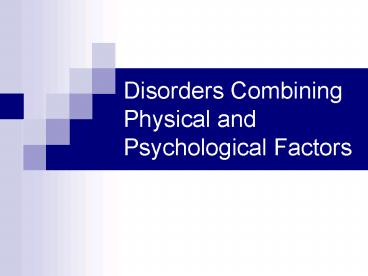Disorders Combining Physical and Psychological Factors - PowerPoint PPT Presentation
1 / 17
Title:
Disorders Combining Physical and Psychological Factors
Description:
The symptoms of a Personality Change Due to a General Medical Condition are ... Current and past nonpsychiatric medical illnesses and surgery ... – PowerPoint PPT presentation
Number of Views:85
Avg rating:3.0/5.0
Title: Disorders Combining Physical and Psychological Factors
1
Disorders Combining Physical and Psychological
Factors
2
Mental Disorders Due to a General Medical
Condition
- The core concept of the diagnostic group is the
occurrence of a mental disorder in association
with a general medical condition that is judged
to be its cause
3
Necessary Clinical Information
- Evidence of a general medical disorder that could
cause the mental disorder (e.g., tumor,
infection) - Recent changes in personality that are not
characteristic for the individual (e.g.,
irritable, labile, disinhibited, impulsive) - Catatonic behavior
4
- Catatonic Disorder Due to a General Medical
Condition (p. 187) - Personality Change Due to a General Medical
Condition (p. 190) - Delirium, Dementia, Amestic Disorder, Psychotic
Disorder, Mood Disorder, Anxiety Disorder, Sexual
Dysfunction, Sleep Disorder Due to a General
Medical Condition - Mental Disorder NOS Due to a General Medical
Condition (p. 190)
5
Key Diagnostic Points
- The symptoms of a Personality Change Due to a
General Medical Condition are usually exaggerated
character or personality traits that do not meet
the criteria for any other diagnostic category.
6
- Jane is a 27-year-old woman who experiences two
or three brief periods of a minute or two each
day when she feels detached from her surroundings
and her own body. Sometimes she cannot remember
what happens during these periods. Friends have
observed these episodes and describe her as
acting distant, as if in a dreamlike state. A
neurological evaluation has demonstrated some
abnormal EEG patterns, although the physician was
unable to provoke one of her dissociative states
during the examination.
7
Diagnosis
- AXIS I
Personality change due to general medical
condition
8
Somatoform Disorders Central features include
- Persistent or recurrent complaints of physical
symptoms not supported by actual physical
findings - Persistent worry about having a physical illness
that is not supported by actual physical findings - Exaggerated concern about minor or imagined
physical defects in an otherwise normal-appearing
person
9
Somatization
- The expression of psychological pain through
physical symptoms or concerns
10
Somatoform Disorders
- Somatization Disorder (p. 490)
- Undifferentiated Somatoform Disorder (p. 492)
- Conversion Disorder (p. 498)
11
- Pain Disorder (p. 503)
- Hypochondriasis (p. 507)
- Body Dysmorphic Disorder (p. 510)
- Somatoform Disorder NOS (p. 511)
12
Necessary Clinical Information
- Current and past nonpsychiatric medical illnesses
and surgery - Current and past worries about illness
- Current medications and abused substances
- Physical symptoms including pain and fatigue
- Degree of distress produced by the physical
symptoms - Psychiatric symptoms
13
- History of stressors
- Impairment in daily functioning
- Stressors (e.g., death, divorce, separation, job
loss) - Psychological conflicts (e.g., dependence vs.
independence) - Psychological needs (e.g., dependency, intimacy,
control) - Typical reaction to external stressors
14
Key Diagnostic Points
- The presence of pain is part of the criteria for
the diagnosis of Somatization Disorder, Pain
Disorder, Undifferentiated Somatoform Disorder,
and Somatoform Disorder NOS. - The loss of pain sensation is a more typical
symptom of Conversion Disorder. - Patients who have Body Dysmorphic Disorder do not
appear to have any physical symptoms to the
outside observer.
15
Factitious Disorders
- The core concept of the diagnostic group is the
individuals attempt, through deception, to feign
physical or emotional illness in order to assume
the role of a patient.
16
- Factitious Disorder (p. 517)
- with Predominantly Psychological Signs and
Symptoms - with Predominantly Physical Signs and Symptoms
- with Combined Psychological and Physical Signs
and Symptoms - Factitious Disorder NOS
17
Key Diagnostic Points
- The clients only motivation for feigning illness
in Factitious Disorders is to assume a sick role.
In contrast, in V65.2 Malingering (p. 739), the
client intentionally produces false or grossly
exaggerated physical or psychological symptoms
motivated by external incentives (e.g., avoiding
work, obtaining financial compensation).































